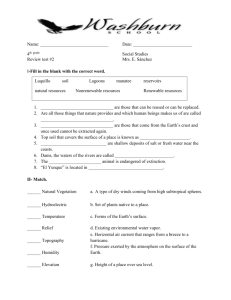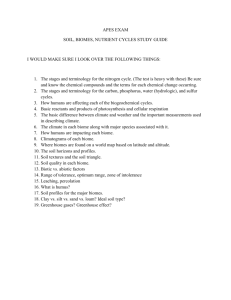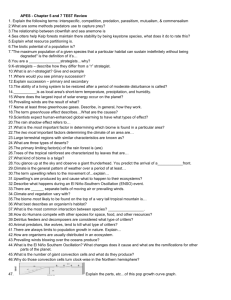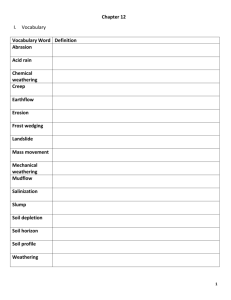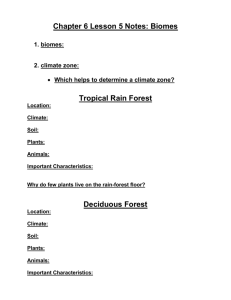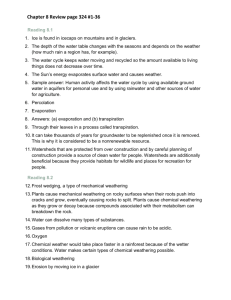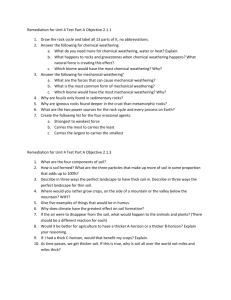L to J Vocabulary
advertisement
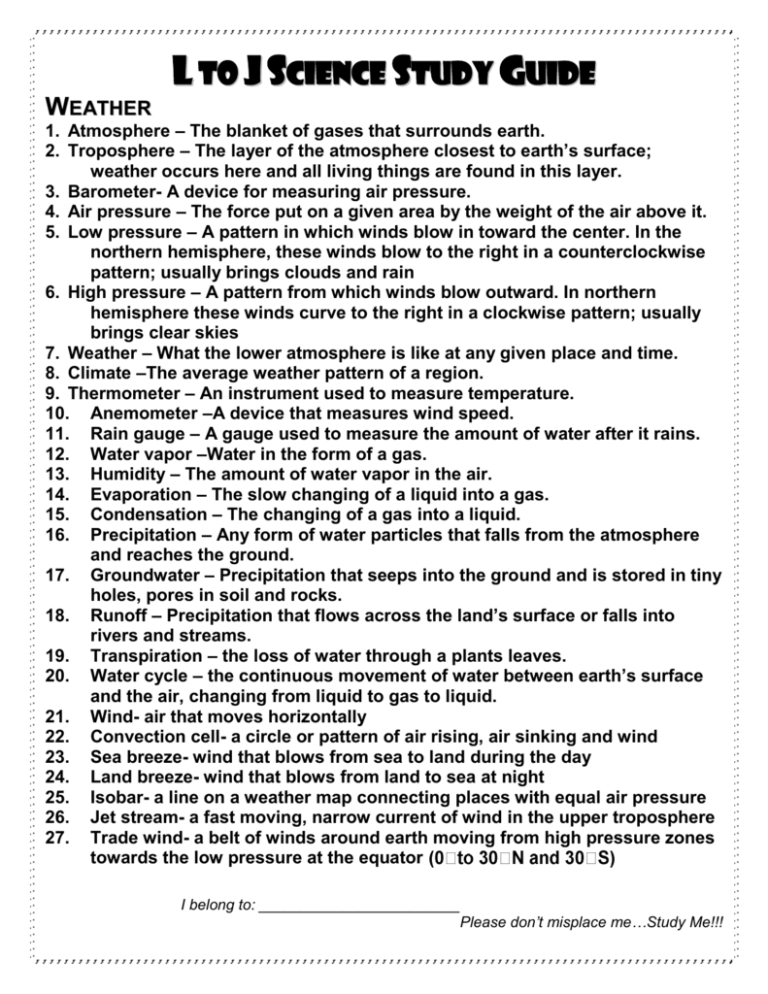
L TO J SCIENCE STUDY GUIDE WEATHER 1. Atmosphere – The blanket of gases that surrounds earth. 2. Troposphere – The layer of the atmosphere closest to earth’s surface; weather occurs here and all living things are found in this layer. 3. Barometer- A device for measuring air pressure. 4. Air pressure – The force put on a given area by the weight of the air above it. 5. Low pressure – A pattern in which winds blow in toward the center. In the northern hemisphere, these winds blow to the right in a counterclockwise pattern; usually brings clouds and rain 6. High pressure – A pattern from which winds blow outward. In northern hemisphere these winds curve to the right in a clockwise pattern; usually brings clear skies 7. Weather – What the lower atmosphere is like at any given place and time. 8. Climate –The average weather pattern of a region. 9. Thermometer – An instrument used to measure temperature. 10. Anemometer –A device that measures wind speed. 11. Rain gauge – A gauge used to measure the amount of water after it rains. 12. Water vapor –Water in the form of a gas. 13. Humidity – The amount of water vapor in the air. 14. Evaporation – The slow changing of a liquid into a gas. 15. Condensation – The changing of a gas into a liquid. 16. Precipitation – Any form of water particles that falls from the atmosphere and reaches the ground. 17. Groundwater – Precipitation that seeps into the ground and is stored in tiny holes, pores in soil and rocks. 18. Runoff – Precipitation that flows across the land’s surface or falls into rivers and streams. 19. Transpiration – the loss of water through a plants leaves. 20. Water cycle – the continuous movement of water between earth’s surface and the air, changing from liquid to gas to liquid. 21. Wind- air that moves horizontally 22. Convection cell- a circle or pattern of air rising, air sinking and wind 23. Sea breeze- wind that blows from sea to land during the day 24. Land breeze- wind that blows from land to sea at night 25. Isobar- a line on a weather map connecting places with equal air pressure 26. Jet stream- a fast moving, narrow current of wind in the upper troposphere 27. Trade wind- a belt of winds around earth moving from high pressure zones towards the low pressure at the equator I belong to: ________________________ Please don’t misplace me…Study Me!!! 28. Prevailing Westerlies- winds that blow from the west to the east that are constantly changing and bring stormy weather; these are this winds that bring weather systems across the United States ( 29. Polar Easterlies – these are the winds that blow from east to west around the north and south poles ) Cold front - a front where cold air moves in under a warm air mass; they pass through quickly and bring thunderstorms, wind and hard rain; the weather turns clear & cooler after it passes Warm front – a front where warm air moves in over a cold air mass; usually associated with stratus clouds that linger and can bring light rain/snow; weather is warm and clear after is passes Stationary front – a front that happens when a warm air mass and a cold air mass meet, and doesn’t move Occluded front – a front that happens when a warm air mass is caught between two cold air masses and is pushed upwards. Rain-Shadow effect – A dry area on a mountain-side facing away from the direction of the wind. The mountains block the passage of rain, casting a “shadow” of dryness behind them. Air mass – a large region of the atmosphere where the air has similar properties throughout with same temperature and humidity 30. 31. 32. 33. 34. 35. FORCES 36. 37. 38. 39. 40. 41. 42. 43. 44. 45. Force – a push or pull that acts on an object Inertia – the way an object resists change in motion (If an object is at rest, it will stay at rest; if an object is in motion it stays in motion until a force acts against it) Friction – a force that acts on a moving object, usually to slow it; works in the opposing direction Speed – how fast am object changes with position in regards to time at any given moment Velocity – the speed of a moving object taken together its direction Acceleration – a change in velocity with respect to time Balanced forces – when all the forces acting on an object cancel each other out; forces are all equal and objects are still – no movement Unbalanced forces – forces that do not cancel each other out when acting together on a single object, causing it to move; one force is greater than another force, causing movement Action- when one object applies force to a second (cause) Reaction – a force a second object returns to the first (effect) I belong to: ________________________ Please don’t misplace me…Study Me!!! 46. 47. 48. 49. 50. 51. 52. 53. 54. 55. 56. 57. 58. 59. 60. 61. 62. 63. Gravity – a force of attraction between any two objects due to their mass (weight) Weight – how heavy something is, the measure of gravity pressing down Work – using force to make an object move Momentum- the result of an objects mass and velocity (momentum = mass x velocity) Air resistance- drag, or the force of air pushing against the motion of an object Simple machine – a device that makes work easier Lever – a rigid bar that sits on a fulcrum Fulcrum – a pivot point Effort arm – the part of a lever that applies force to the resistant arms; where you apply the force Resistant arm – the part of a lever that applies forces to the load the machine acts against; where the load is Wedge – an inclined plane that is used for splitting objects (ie. an ax) Pulley – wheel with a groove in the rim (ie. Crane) Inclined plane – a flat-sided slanted surface that makes it easier to move heavy objects to higher levels (ie. A truck ramp) Wheel and axle – a large diameter wheel that rotates around a small diameter wheel (ie. Wheels of a car) Screw – an inclined plane wrapped in a spiral around a cylinder cone (ie. A screw) Newton’s 1st Law - An object at rest will remain at rest unless acted on by an unbalanced force. An object in motion continues in motion with the same speed and in the same direction unless acted upon by an unbalanced force. This law is often called "the law of inertia". Newton’s 2nd Law - Acceleration is produced when a force acts on a mass. The greater the mass (of the object being accelerated) the greater the amount of force needed (to accelerate the object). Newton’s 3rd Law - For every action there is an equal and opposite reaction. ECOSYTEMS 64. 65. 66. 67. 68. 69. Population- all the members of a species in an area Habitat- the place where animals or plants naturally live and grow Community- The interaction of all the living things in a area. Organism- Any living thing that can carry out its life on its own Abiotic Factors - the non-living parts of an ecosystem Biotic Factors- the living things or once-living organisms in an ecosystem I belong to: ________________________ Please don’t misplace me…Study Me!!! 70. 71. 72. 73. 74. 75. 76. 77. 78. 79. 80. 81. 82. 83. 84. 85. 86. 87. 88. 89. 90. Ecology- The study of how the living and non living things in an ecosystem interact studying this process. Ecosystem- All the living and non living things in an environment, including their interactions with each other Biome- One of the Earths largest ecosystems with its own kind of Climate, soil, and animals. The main biomes are Tundra, Deciduous forest, Grasslands, Tropical Rainforest, Desert, Taiga, Estuary, Marine, and Freshwater. Desert- A sandy or rocky biome with little precipitation and little plant life Tundra- A large, treeless plain in the Arctic regions where the ground is frozen all year Deciduous Forest- A Forest Biome with many kinds of trees and lose their leaves each autumn. It has 4 seasons and the word deciduous means “decay.” Tropical Rainforest- A hot biome near the equator, with much rainfall and a wide variety of life Grasslands- A biome where grasses are the main plant life Taiga- A coniferous forest biome with acidic minerals and poor soil with many lakes that were formed by melting glaciers; all of this biome is covered by non-deciduous trees such as evergreens, spruce trees and fir trees; Marine- a salt water biome; it is divided into 4 sections from the top to the bottom. Estuary- A place where fresh and saltwater meet in a coastal area Freshwater- to do with or living in water that does not contain salt, as in fresh water fish Decomposers- Any of the fungi or bacteria that break down dead plants and animals into useful things like minerals and rich soil. Omnivore- When animals and humans eat both meat and plants Eutrophication- The addition of artificial or natural substances into an environment Biodegradable- Capable of being broken down by natural process, such as Bacteria Scavengers-They are meat eaters that don’t hunt and look for dead animals. Urbanization- to make or become urban; to become busy or congested as well as developed as or like a city. Food Chain- The path of energy in food from one organism to another; how energy goes from producers to consumers to decomposers. Prey- a living thing that is hunted for food. Consumer- Organisms that cannot produce their own food and consume other organisms I belong to: ________________________ Please don’t misplace me…Study Me!!! 91. 92. 93. 94. 95. 96. 97. 98. Landfill- A site for the disposal of waste of material by burial Producer- Any of the plants and algae that produce oxygen and food that animals need. Niche- The role an organism plays in an ecosystem. Food Web- The overlapping food chains in an ecosystem Herbivore- An animal that eats plants, algae, and other producers. Predator-A living thing that eats other living things. Carnivores- An animal that eats another animal. Pollutants- something that causes pollution. LANDFORMS 99. Weathering – breaking down of rocks into smaller pieces 100. Mechanical weathering – objects that are physically broken into smaller pieces by wind, water, ice and heat 101. Chemical weathering – is a process in which the rocks are broken down by removing or altering elements that make up the minerals 102. Biological weathering – weathering that is mechanical or chemical, but always caused by living organisms 103. Erosion – the movement of soil or rock by water, ice or wind; it is the movement of weathered rock and not the weathering itself (her forms of the word include: erode, eroded, eroding) 104. Slope – the incline or steepness of a surface 105. Saturated – to become full of, typically of water 106. Glacier – a large body of ice moving slowly down a slope due to the force of gravity; it picks up and carries loose material in its path, moving tons of sediment. 107. Valley – a low area between two mountains that was formed long ago (if it is formed by a river, it is V-shaped; if is formed by a glacier, it is U Shaped) 108. Flood – the great overflow of water of land that is usually dry 109. Flash Flood – sudden and destructive rush of water down a narrow gully or over a sloping surface caused by heavy rainfall 110. Delta - a piece of land in the shape of a triangle or fan, made by deposits of mud and sand at the mouth of a river 111. Sediment – small pieces of rock and soil that is transported from one location to another 112. Meander – an S-shaped curve or bend in a river ; formed by erosion and deposition changing the shape of a river 113. Tributary – small streams or rivers that flow into a larger river; usually begins at or in the mountains (when they join the larger river, the larger river increases in volume and speeds up) I belong to: ________________________ Please don’t misplace me…Study Me!!! 114. Landforms – features of the surface of the earth (ex. Valleys, canyons, mountains, hills, plateaus, and plains) 115. Silt – very finely-ground rock; easily transported in water or other liquids and is fine enough to be carried long distances by air in the form of dust; formed by mechanical weathering 116. Gravity – the force that pulls everything towards the center of the Earth 117. Landslide – the downward falling or sliding of a mass of soil or rock on the side of a mountain 118. Deposition – the state of sediment being deposited or placed in an area; typically water deposits sediment where the water slows (ie. at the inside bend of a meander or at the mouth of a river) 119. Tsunami – a very large destructive wave caused by an underwater earthquake or volcano 120. Drought – long periods of dry weather; a lack of rainfall in an area can cause this, making the ground look cracked and dry 121. Mouth – the part or a stream or river where its waters are released into a river or larger body of water 122. Oxbow lake – a lake formed when the meander gets cut off from the main stream of water 123. Deposition bank – the outside of a meander where soil/sediment is deposited 124. Erosion bank – the inside of a meander where soil is eroded by faster moving water 125. Flood plain – low flat land along a stream that is flooded when the stream overflows 126. Wind erosion – the wind picks up small pieces of rock fragment and carries them along until they reach an obstacle, such as a hill or a plant 127. Scale – relates the distance on a map to the real distance on the earth’s surface 128. Topographic maps – maps that show the height or elevation of the land using contour lines 129. Contour Lines – lines hat connect areas on the surface with the same elevation 130. Relief maps – a type of map that uses shading and coloring to show differences in elevation 131. Deforestation – removal of trees in the forest 132. Windbreaks – tall trees surrounding farm areas to prevent winds from carrying off too much topsoil 133. Soil Terracing – making hilly areas into step like formations that slow water and help reduce runoff 134. Irrigation – watering of soil when it is dry I belong to: ________________________ Please don’t misplace me…Study Me!!!
